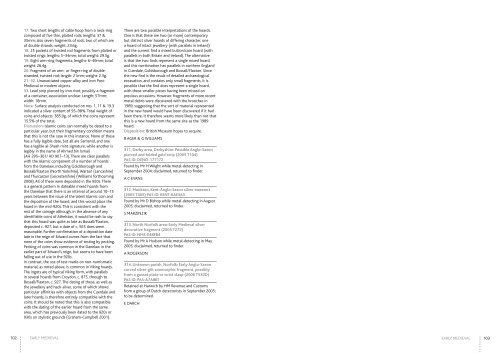TREASURE ANNU AL REPORT 2005/6 - Portable Antiquities Scheme
TREASURE ANNU AL REPORT 2005/6 - Portable Antiquities Scheme
TREASURE ANNU AL REPORT 2005/6 - Portable Antiquities Scheme
Create successful ePaper yourself
Turn your PDF publications into a flip-book with our unique Google optimized e-Paper software.
17. Two short lengths of cable hoop from a neck-ring<br />
composed of five thin, plaited rods; lengths: 37 &<br />
35mm; also seven fragments of rods, two of which are<br />
of double strands; weight: 23.6g.<br />
18. 25 packets of twisted rod fragments from plaited or<br />
twisted rings; lengths: 5–34mm; total weight: 29.5g.<br />
19. Eight arm-ring fragments; lengths: 6–49mm; total<br />
weight: 26.4g.<br />
20. Fragment of an arm- or finger-ring of doublestranded,<br />
twisted rod; length: 21mm; weight: 2.3g.<br />
21–32. Unassociated copper-alloy and iron Post-<br />
Medieval or modern objects.<br />
33. Lead strip pierced by iron rivet, possibly a fragment<br />
of a container, association unclear. Length: 57mm;<br />
width: 18mm.<br />
Note: Surface analysis conducted on nos. 1, 11 & 19.3<br />
indicated a silver content of 95–98%. Total weight of<br />
coins and objects: 385.9g, of which the coins represent<br />
15.5% of the total.<br />
Discussion: Islamic coins can normally be dated to a<br />
particular year, but their fragmentary condition means<br />
that this is not the case in this instance. None of these<br />
has a fully legible date, but all are Samanid, and one<br />
has a legible al-Shash mint signature, while another is<br />
legibly in the name of Ahmed bin Ismail<br />
(AH 295–301/ AD 907–13). There are clear parallels<br />
with the Islamic component of a number of hoards<br />
from the Danelaw, including Goldsborough and<br />
Bossall/Flaxton (North Yorkshire), Warton (Lancashire)<br />
and Thurcaston (Leicestershire) (Williams forthcoming<br />
2008). All of these were deposited in the 920s. There<br />
is a general pattern in dateable mixed hoards from<br />
the Danelaw that there is an interval of around 10–15<br />
years between the issue of the latest Islamic coin and<br />
the deposition of the hoard, and this would place the<br />
hoard in the mid-920s. This is consistent with the<br />
rest of the coinage although, in the absence of any<br />
identifiable coins of Athelstan, it would be rash to say<br />
that this hoard was quite as late as Bossall/Flaxton,<br />
deposited c. 927, but a date of c. 925 does seem<br />
reasonable. Further confirmation of a deposition date<br />
late in the reign of Edward comes from the fact that<br />
none of the coins show evidence of testing by pecking.<br />
Pecking of coins was common in the Danelaw in the<br />
earlier part of Edward’s reign, but seems to have been<br />
falling out of use in the 920s.<br />
In contrast, the use of test marks on non-numismatic<br />
material, as noted above, is common in Viking hoards.<br />
The ingots are of typical Viking form, with parallels<br />
in several hoards from Croydon, c. 875, through to<br />
Bossall/Flaxton, c. 927. The dating of these, as well as<br />
the jewellery and hack-silver, some of which shows<br />
particular affinities with objects from the Cuerdale and<br />
later hoards, is therefore entirely compatible with the<br />
coins. It should be noted that this is also compatible<br />
with the dating of the earlier hoard from the same<br />
area, which has previously been dated to the 920s or<br />
930s on stylistic grounds (Graham-Campbell 2001).<br />
There are two possible interpretations of the hoards.<br />
One is that these are two (or more) contemporary<br />
but distinct silver hoards of differing character, one<br />
a hoard of intact jewellery (with parallels in Ireland)<br />
and the current find a mixed bullion/coin hoard (with<br />
parallels in both Britain and Ireland). The alternative<br />
is that the two finds represent a single mixed hoard,<br />
and this combination has parallels in northern England<br />
in Cuerdale, Goldsborough and Bossall/Flaxton. Since<br />
the new find is the result of detailed archaeological<br />
excavation, and contains only small fragments, it is<br />
possible that the find does represent a single hoard,<br />
with these smaller pieces having been missed on<br />
previous occasions. However, fragments of more recent<br />
metal debris were discovered with the brooches in<br />
1989, suggesting that the sort of material represented<br />
in the new hoard would have been discovered if it had<br />
been there. It therefore seems more likely than not that<br />
this is a new hoard from the same site as the 1989<br />
hoard.<br />
Disposition: British Museum hopes to acquire.<br />
B AGER & G WILLIAMS<br />
311. Derby area, Derbyshire: possible Anglo-saxon<br />
pierced and folded gold strip (<strong>2005</strong> T104)<br />
pAs ID: DENo-177172<br />
Found by Mr H Wright while metal-detecting in<br />
September 2004; disclaimed, returned to finder.<br />
A C EVANS<br />
312. monkton, Kent: Anglo-saxon silver tweezers<br />
(<strong>2005</strong> T305) pAs ID: KENT-6AE3A5<br />
Found by Mr D Bishop while metal-detecting in August<br />
<strong>2005</strong>; disclaimed, returned to finder.<br />
S MARZINZIK<br />
313. North Norfolk area: Early medieval silver<br />
decorative fragment (<strong>2005</strong> T272)<br />
pAs ID: Nms-E48Fb4<br />
Found by Mr A Hudson while metal-detecting in May<br />
<strong>2005</strong>; disclaimed, returned to finder.<br />
A ROGERSON<br />
314. unknown parish, Norfolk: Early Anglo-saxon<br />
curved silver-gilt zoomorphic fragment, possibly<br />
from a gusset plate or wrist clasp (2006 T532D)<br />
pAs ID: pAs-A7A881<br />
Retained at Harwich by HM Revenue and Customs<br />
from a group of Dutch detectorists in September <strong>2005</strong>;<br />
to be determined.<br />
E DARCH<br />
102 EARLY MEDIEV<strong>AL</strong> EARLY MEDIEV<strong>AL</strong> 103





